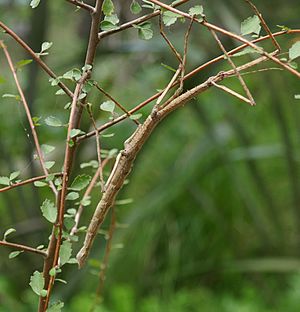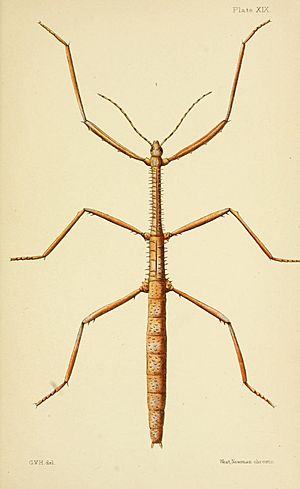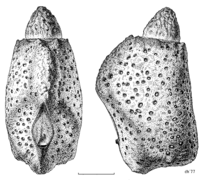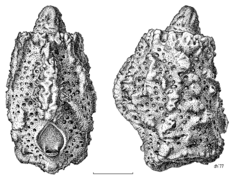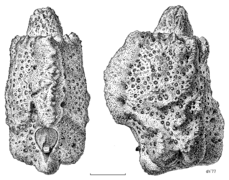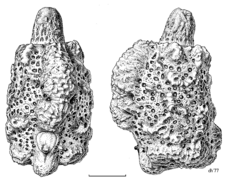Argosarchus facts for kids
Quick facts for kids Argosarchus |
|
|---|---|
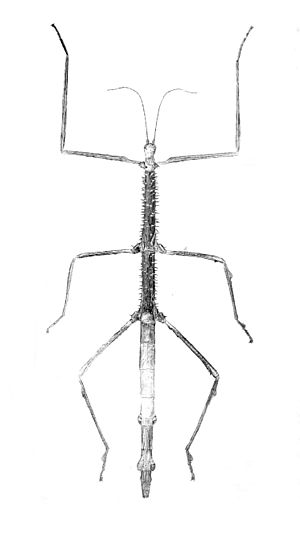 |
|
| Argosarchus horridus by William Wing | |
| Scientific classification | |
| Kingdom: | |
| Phylum: | |
| Class: | |
| Order: | |
| Suborder: | |
| Family: | |
| Subfamily: |
Phasmatinae
|
| Genus: |
Argosarchus
Hutton, 1898
|
| Species: |
A. horridus
|
| Binomial name | |
| Argosarchus horridus (White, 1846)
|
|
| Synonyms | |
|
Argosarchus spiniger (White, 1846) |
|
The Argosarchus horridus, also known as the New Zealand bristly stick insect, is a special type of stick insect. It is the only species in its group, called a monotypic genus. This amazing insect lives only in New Zealand, meaning it is endemic there. The name "horridus" comes from Latin and means "bristly," which probably refers to the spiky parts on its body.
Contents
Discover the New Zealand Bristly Stick Insect
The New Zealand bristly stick insect is quite impressive in size. Female stick insects can grow up to 20 centimetres (7.9 in) long. This makes them the longest insects found in New Zealand. Males are much smaller and thinner, usually growing up to 10 centimetres (3.9 in).
One cool way to tell them apart is by looking at their front legs. The part of their leg closest to the body, called the coxa, is often purple or pink. Females also have a very spiky body, especially on their thorax (the middle part).
These stick insects come in different colors. They can be light white to dark brown. Females are usually grey, while males are often a dark greenish-brown or dark brown.
Life Cycle and Reproduction of A. horridus
Like many other stick insects in New Zealand, A. horridus can reproduce in a special way called parthenogenesis. This means that some groups of these stick insects have only females. These females can lay eggs that hatch without needing a male. Other groups have both males and females, and they can reproduce either asexually (without a male) or through sexual reproduction.
Adult stick insects hatch in early summer. You can often see them hanging on their favorite plants, eating leaves. They are usually most active at night. Males will actively search for females during this time.
Mating Behavior
When males find a female, they climb onto her back. They use special toothed claspers near their reproductive parts to hold on and start mating. Sometimes, a male might stay attached to a female even when they are not mating. This is called "mate-guarding," and it helps make sure other males don't mate with her.
Female stick insects lay eggs continuously throughout their adult lives. They simply drop the eggs to the ground. These eggs are large and look a lot like plant seeds. This helps them blend in perfectly with the leaves and dirt on the forest floor.
From Egg to Adult
The eggs hatch in early spring. The young stick insects, called nymphs, look like tiny versions of the adults. A. horridus grows through a process called hemimetabolous development. This means they don't have a pupa stage like butterflies. Instead, nymphs grow by shedding their outer skin, a process called moulting. They go through six moults, or "instars," before they become full-grown adults.
- ''Argosarchus horridus'' eggs illustrated by Des Helmore
Where A. horridus Lives
The New Zealand bristly stick insect can be found in many parts of the North Island of New Zealand. It also lives in some areas of the South Island. You can spot them in places near the coast, from sea level up to about 900 meters (about 3,000 feet) high. However, they are not found in the middle of the South Island or in very high mountain areas.
These stick insects have also been found on several islands off the coast, including the Chatham Islands. Interestingly, on the Chatham Islands, only female stick insects are found. This group was once thought to be a different species.
A. horridus can live in many different places and eat various plants. You might find them in gardens on ramarama plants (Lophomyrtus bullata). In the wild, they live on native and introduced Rubus species (like blackberries) and climbing rata (Metrosideros perforata). Because they can live in so many different habitats and eat different plants, A. horridus is considered an "ecological generalist." This means they are very adaptable to their environment.


